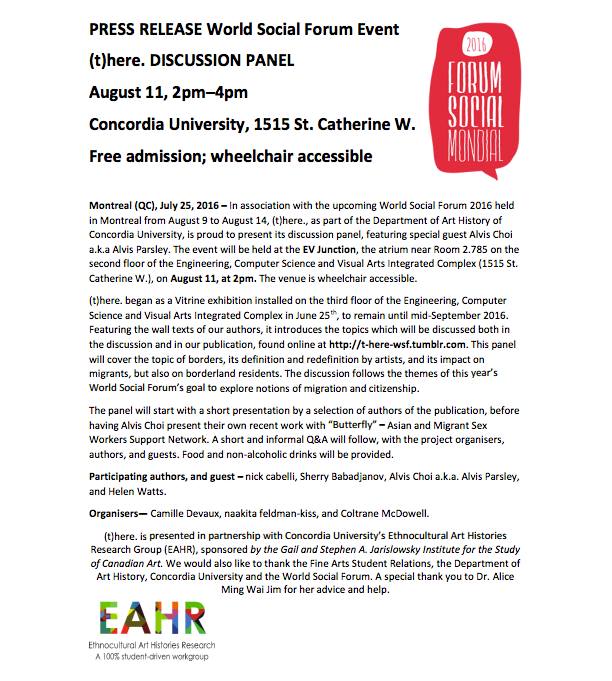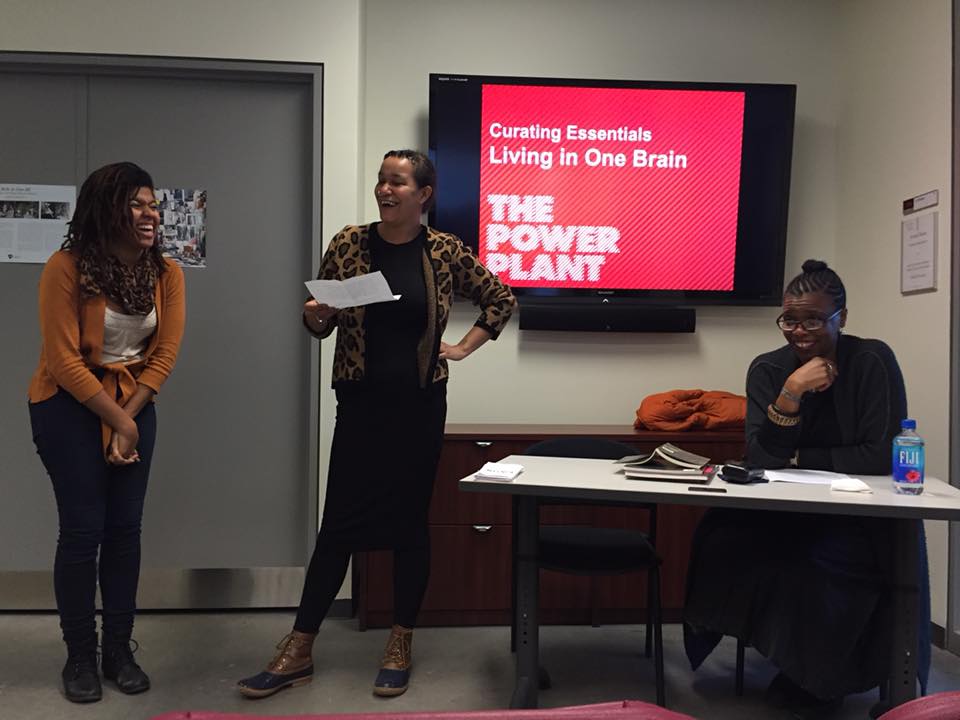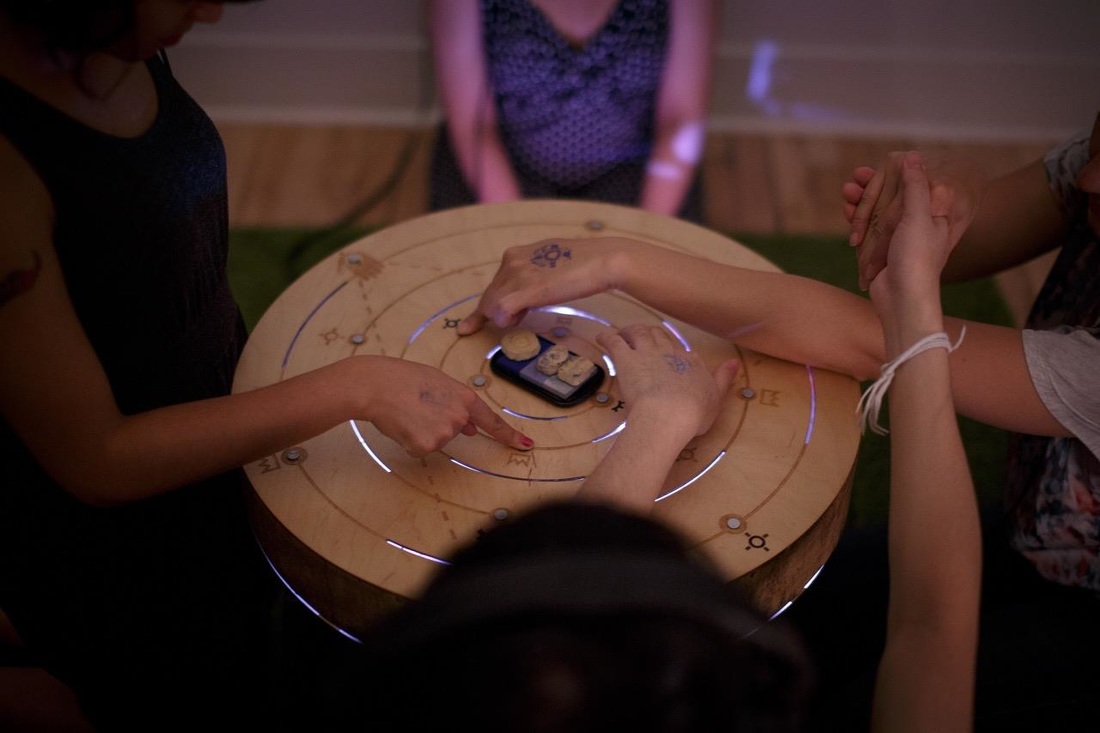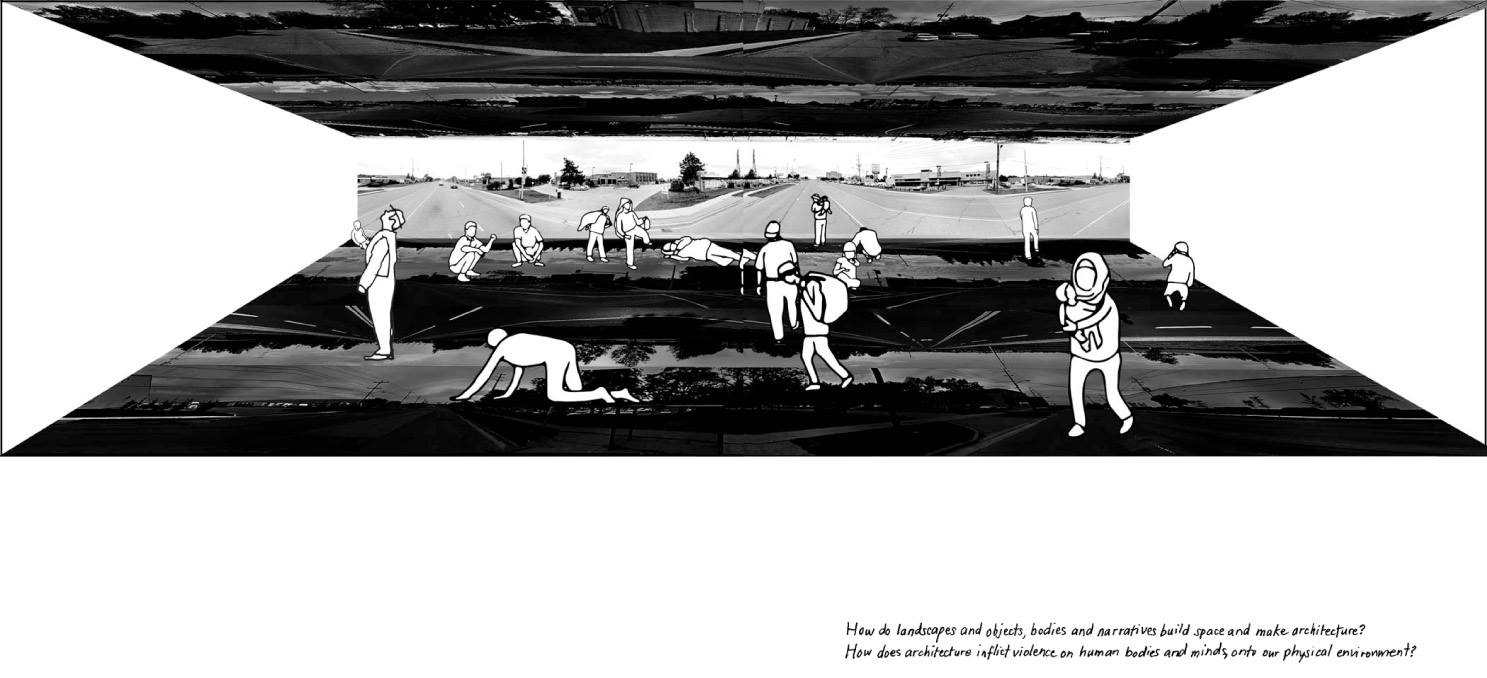|
Vernissage: Fri. Dec. 2, 5 - 7pm Exhibition: Dec. 1 - 4, 11am - 8pm The Ethnocultural Art Histories Research Group (EAHR) is proud the group exhibition Canada 389 an exhibition part of Atelier Céladon's curatorial project Étrangers communs / Common Aliens: Diaspora in Time. The exhibition features the work of four artists who engage with complexities of commemoration, race and ethnocultural representation in Canada. This exhibition seeks to expand our understanding of diversity and national identity by addressing histories of inclusion and exclusion in the realm of what constitutes the nation state in the public imaginary. The year 2017 will mark significant historic anniversaries for Quebec and Canada, including the 150th anniversary of Canadian Confederation (1867), the 375th anniversary of the City of Montreal (1642), the 70th anniversary of Canadian Citizenship Act (1947), and the 50th anniversary of Expo 67. Bearing in mind an ethics of commemoration, this exhibition asks how contemporary art can help us to understand the responsibility to commemorate as a critical practice especially when historical facts of racism in Canada force us to confront the underrepresentation of culturally-diverse communities in official national histories. Canada 389 is a clear reference to the year 1648 when the first Black slave, a young 8 or 9 year-old boy given the name of Olivier Le Jeune, was sold in Montreal (New France). The exhibition unfolds as a generative space to develop and trigger a conversation concerning identity issues that confronts the present and the future with notions of stereotypes, acculturation, ethnic visual markers, reclamation of histories, and hidden and undocumented sites. Participating artists: TINGS CHAK PRIYA ZOE JAIN FABIAN JEAN MARY SUI YEE WONG With texts by Nick Cabelli, Melinda Pierre-Paul Cardinal, Gianna Mardakis, and Gabrielle Montpetit  August 11, 2pm–4pm Concordia University, 1515 St. Catherine W. (EV Junction, the atrium near Room 2.785) Free admission; wheelchair accessible In association with the upcoming World Social Forum 2016 held in Montreal from August 9 to August 14, (t)here., as part of the Department of Art History of Concordia University, is proud to present its discussion panel, featuring special guest Alvis Choi a.k.a Alvis Parsley. The event will be held at the EV Junction, the atrium near Room 2.785 on the second floor of the Engineering, Computer Science and Visual Arts Integrated Complex (1515 St. Catherine W.), on August 11, at 2pm. The venue is wheelchair accessible. (t)here. began as a Vitrine exhibition installed on the third floor of the Engineering, Computer Science and Visual Arts Integrated Complex in June 25th, to remain until mid-September 2016. Featuring the wall texts of our authors, it introduces the topics which will be discussed both in the discussion and in our publication, found online at http://t-here-wsf.tumblr.com/ This panel will cover the topic of borders, its definition and redefinition by artists, and its impact on migrants, but also on borderland residents. The discussion follows the themes of this year’s World Social Forum’s goal to explore notions of migration and citizenship. The panel will start with a short presentation by a selection of authors of the publication, before having Alvis Choi present their own recent work with “Butterfly” – Asian and Migrant Sex Workers Support Network. A short and informal Q&A will follow, with the project organisers, authors, and guests. Food and non-alcoholic drinks will be provided. Participating authors, and guest – nick cabelli, Sherry Babadjanov, Alvis Choi a.k.a. Alvis Parsley, and Helen Watts. Organisers— Camille Devaux, naakita feldman-kiss, and Coltrane McDowell. (t)here. is presented in partnership with Concordia University’s Ethnocultural Art Histories Research Group (EAHR), sponsored by the Gail and Stephen A. Jarislowsky Institute for the Study of Canadian Art. We would also like to thank the Fine Arts Student Relations, the Department of Art History, Concordia University and the World Social Forum. A special thank you to Dr. Alice Ming Wai Jim for her advice and help.  Living in One Brain Gaëtane Verna (Power Plant, Toronto) In this presentation Verna will talk about the development of her curatorial vision and practice, from her early days as director of the Foreman Art Gallery at Bishops’s University in Sherbrooke, Quebec, through to her current position as director of The Power Plant. Gaëtane Verna has been the Director of The Power Plant Contemporary Art Gallery in Toronto, Canada’s leading public gallery devoted exclusively to contemporary visual art since March 2012. Before taking up the post at The Power Plant, she was Executive Director and Chief Curator of the Musée d'art de Joliette in Lanaudière, Quebec for six years. From 1998 to 2006, she was the curator of the Foreman Art Gallery at Bishop’s University, while also teaching in the Art History department of both Bishop’s University and the Université du Québec à Montréal. She has many years of experience in curating, presenting, publishing catalogues and organizing exhibitions by emerging, mid-career and established Canadian and international artists such as Vasco Araújo, Alfredo Jaar, Luis Jacob, Shelagh Keeley, Kimsooja, Yam Lau, Oswaldo Maciá, Ed Pien, Pedro Cabrita Reis, Pedro Reyes, Gabor Szilasi, Javier Tellez, Denyse Thomasos, YOUNG HAE CHANG HEAVY INDUSTRIES and Zineb Sedira, among many others. -- The Ethnocultural Art History Research Group (EAHR) is proud to be co-presenting this lecture as part of a series of conversations hosted by the Gail and Stephen A. Jarislowsky Institute for Studies in Canadian Art entitled Afternoons at the Institute. Bringing established and emerging scholars together, the series focuses on pressing questions and current issues in the research and writing of art histories. The series has been made possible by a generous donation from the Jarislowsky Foundation. All Afternoon at the Institute conversations are held in EV-3.725, the Gail and Stephen A. Jarislowsky Institute for Studies in Canadian Art, on the 3rd floor of the Engineering, Computer Science and Visual Arts Complex, 1515 Ste-Catherine Street West. Metro Guy-Concordia (map). Conversation are free and open to the public.  (English Below) Dissonant Integrations 5 mars au 2 avril 2016 Vernissage: le samedi 5 mars, 15h-18h, à la Galerie Z Art Space. Gratuit et ouvert au public. Ethnocultural Art Histories Research (EAHR) est heureux de présenter Dissonant Integrations, une exposition collective et un programme vidéo qui s’intéressent à la perturbation comme outil de contestation des représentations dominantes de la race, de l’ethnicité ainsi que d’autres formes d’identités fixes. Présentant douze artistes et collectifs basé-e-s au Canada et aux États-Unis, Integrations Dissonant cherche à élargir notre compréhension de la diversité par le biais des œuvres qui perturbent les stéréotypes ethniques et/ou raciaux, ainsi que les récits essentialistes de l'identité et des représentations culturelles. De la photographie et la vidéo à la sculpture, les artistes sélectionnés travaillent à partir d’une variété de médias et recourent à des pratiques créatives diverses, telles que la réutilisation, l’autoethnographie et l'appropriation. Explorant les thèmes du déplacement, de l'immigration et de la diaspora, les artistes utilisent l'ironie, l'humour et l'expérimentation pour naviguer à la fois entre la représentation publique et de soi, l’identité nationale et mondiale, le familier et l'inconnu. En jetant une lumière sur les défis quotidiens auxquels font face les communautés ethnoculturelles, ces artistes explorent des problèmes sociopolitiques urgents qui ne cessent d’alimenter et de remettre en question le discours de l'art contemporain. L’exposition Dissonant Integrations marque le cinquième anniversaire du groupe de recherche Ethnocultural Art Histories Research (EAHR), fondé en 2011. Elle s’inscrit en continuité avec son mandat visant à faciliter les possibilités d'échange et de création dans l’analyse des aspects liés à la représentation ethnique et culturelle dans les arts visuels au Canada. EAHR regroupe une communauté d'étudiant-e-s et de chercheur-e-s à travers le Canada issu-e-s principalement de l'Université Concordia, de l'Université McGill et de l'Université de Montréal. Artistes Ifeoma U. Anyaeji, Victor Arroyo, Pansee Atta, Minhee Bae, Richenda Grazette, Fanny Latreille-Beaumont, Kimura Byol-Nathalie Lemoine, Eva-Loan Pontom-Pham, Shay (Shawn M. & Ayse B.), Team Sagittarius, Alisi Telengut, Karen White. EAHR tient à remercier les entités suivantes pour leur généreux soutien : Gail and Stephen A. Jarislowsky Institute for Studies in Canadian Art, Fine Arts Student Alliance, Concordia Council on Student Life, Department of Art History et Art History Graduate Student Association de l’Université Concordia, Concordia Student Union, la galerie Z Art Space, Kafein, articule et OPTICA. ------- Dissonant Integrations March 5 – April 2, 2016 Opening Reception: Saturday, March 5, 3pm - 6pm, at Z Art Space. Free and Open to the Public. Montreal (QC) - Ethnocultural Art Histories Research (EAHR) is delighted to present Dissonant Integrations, a group exhibition and video program investigating disruption as a tool to challenge dominant representations of race, ethnicity and other forms of fixed identities. Featuring twelve artists and collectives based in Canada and the United States, Dissonant Integrations seeks to expand our understanding of diversity through artworks that disrupt ethnic and/or racial stereotypes, and redress essentialist narratives of cultural identities and representations. From photography and video to sculpture, the selected artists work in a range of media and draw on various creative practices, such as upcycling, auto-ethnography and appropriation. Exploring themes of displacement, immigration and diaspora, the artists use irony, humor and experimentation to navigate between public and self-representation, national and global identity, the familiar and the unfamiliar. By unraveling the everyday challenges faced by ethnocultural communities, these artists engage with pressing social-political issues that continually fuel and challenge contemporary art discourse. Dissonant Integrations marks the fifth-year anniversary of Ethnocultural Art Histories Research Group (EAHR) since its founding in 2011 and demonstrates EAHR’s ongoing pursuit to facilitate opportunities for exchange and creation in the examination of issues of ethnic and cultural representation within the visual arts in Canada. EAHR is a community of students and researchers from across Canada, including Concordia University, McGill University and University of Montreal. Artists Ifeoma U. Anyaeji, Victor Arroyo, Pansee Atta, Minhee Bae, Richenda Grazette, Fanny Latreille Beaumont, Nathalie Lemoine, Eva-Loan Pontom-Pham, Shay (Shawn M. & Ayse B.), Team Sagittarius, Alisi Telengut, Karen White. EAHR would like to thank the generous support of the Gail and Stephen A. Jarislowsky Institute for Studies in Canadian Art, the Fine Arts Student Alliance, the Concordia Council on Student Life, Concordia’s Department of Art History and Art History Graduate Student Association, Concordia Student Union, Z Art Space, Kafein, articule and OPTICA. **Nouvelle! Date limite prolongée jusqu'au 22 Janvier 2016
**Updates! Deadline extended to January 22, 2016 Le groupe Ethnocultural Art Histories Research (EAHR) de l'Université Concordia vous invite à soumettre des œuvres d'art complétées pour une exposition collective qui aura lieu à la galerie Z Art Space en mars 2016. L’exposition mettra l'accent sur les actes ou les cas de perturbation des stéréotypes ethniques et/ou raciaux à travers des œuvres créatives qui cherchent à redresser et à ébranler les récits essentialistes sur l'identité culturelle. EAHR est à la recherche d'œuvres qui emploient ou analysent la perturbation comme outil qui sape les représentations raciales et des identités fixes ou qui élargit notre compréhension des identités ethnoculturelles. Les thèmes incluent: • Les stéréotypes • Le déplacement • Le racisme • La xénophobie Les candidatures des étudiant(e)s et des artistes actifs de toutes les disciplines et les niveaux d'expérience sont les bienvenues. Nous vous invitons à participer en usant d’une variété de médias artistiques différents (peinture, sculpture, photographie, performance, etc.) Les candidatures individuelles tout comme les collaborations interdisciplinaires sont encouragées. Nous informerons de la décision du comité commissarial en fin janvier. QUAND: 5 au 26 mars 2016 OÙ: Z Art Space (www.zartspace.com) CRITÈRES: 1) Un maximum de 5 oeuvres complétées (inclure titre, date, médium et dimensions) 2) Biographie d’artiste (100 mots) 3) Démarche artistique (200 mots) 4) Une documentation visuelle (10 images maximum) ***Cachet d’artiste selon les normes du Front des artistes canadiens (CARFAC)*** FORMULAIRE DE SOUMISSION DISPONIBLE SUR https://goo.gl/VnQHNT LES CANDIDATURES DOIVENT ÊTRE ENVOYÉES À: [email protected] DATE LIMITE: 22 JANVIER 2016 ************ Concordia’s Ethnocultural Art Histories Research Group (EAHR) invites you to submit completed works of art for an upcoming group exhibition taking place in March 2016. The exhibition will take place at gallery Z Art Space and focus on acts or instances of disruption of ethnic and/or racial stereotypes through creative works that seek to redress and unsettle essentialist narratives about cultural identity. EAHR is looking for works which employ or investigate disruption as a tool that undermines representations of race and fixed identity or expand our understanding of ethnocultural identities. Themes include: • Stereotypes • Displacement • Racism • Xenophobia Applications are welcomed from students and practicing artists from all disciplines and levels of experience. All are encouraged to participate using a variety of artistic media (painting, sculpture, photography, performance, etc.) The submission of both individual works and interdisciplinary collaborations are encouraged. We will notify you of the curatorial committee selection by the end of January. WHEN: March 5 – 26, 2016 WHERE: Z Art Space (www.zartspace.com) CRITERIA: 1. Maximum of 5 completed artworks (include title, date, medium, dimensions) 2. Artist Bio (100 words) 3. Artist statement (200 words) 4. Visual documentation of artworks (max 10 images) *** Participating artists will be issued artists' fees as per CARFAC guidelines*** SUBMISSION FORM AVAILABLE at: https://goo.gl/EJtZXK ALL SUBMISSIONS MUST BE EMAILED TO: [email protected] DEADLINE: JANUARY 22, 2016 // À PROPOS EAHR (Ethnocultural Art Histories Research) regroupe une communauté de chercheur-e-s pilotée par les étudiant-e-s du Département d'histoire de l'art de l'Université Concordia (Montréal, QC). Depuis l'été 2011, EAHR facilite les occasions d'échange et de création liées à l'examen et l'engagement de la représentation ethnique et culturelle dans les arts visuels au Canada. EAHR compte actuellement des membres étudiant-e-s et chercheur-e-s provenant de Concordia, McGill, UdeM et d'ailleurs à travers l'Amérique du Nord. // ABOUT US Ethnocultural Art Histories Research (EAHR) is a student-driven research community based within the Art History Department of Concordia University (Montreal, QC). Since summer 2011, EAHR facilitates opportunities for exchange and creation in the examination of and engagement with issues of ethnic and cultural representation within the visual arts in Canada. EAHR currently holds the membership and active involvement of students and researchers from Concordia, McGill, UdeM, as well as diverse communities throughout North America. |
Concordia University is located on unceded Indigenous lands. The Kanien’kehá:ka Nation is recognized as the custodians of the lands and waters on which we gather today. Tiohtiá:ke/Montreal is historically known as a gathering place for many First Nations. Today, it is home to a diverse population of Indigenous and other peoples. We respect the continued connections with the past, present and future in our ongoing relationships with Indigenous and other peoples within the Montreal community.
For more information, please visit: https://www.concordia.ca/about/indigenous/territorial-acknowledgement.html
Credits: EAHR's logo was created and designed by Adrienne Johnson, co-founder of EAHR / notre logo a été créé par Adrienne Johnson, co-fondatrice de EAHR.
Copyright © 2018


 RSS Feed
RSS Feed